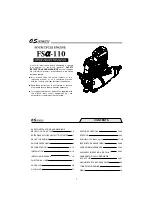
84
Disassembly/Inspection and Service
KohlerEngines.com
66 690 14 Rev. A
Inspect gear teeth of crankshaft. If teeth are badly worn,
chipped, or some are missing, replacement of crankshaft
will be necessary.
Inspect crankshaft bearing surfaces for scoring,
grooving, etc. Measure running clearance between
crankshaft journals and their respective bearing bores.
Use an inside micrometer or telescoping gauge to
measure inside diameter of both bearing bores in vertical
and horizontal planes. Use an outside micrometer to
measure outside diameter of crankshaft main bearing
journals. Subtract journal diameters from their respective
bore diameters to get running clearances. Check results
against values in Speci
fi
cations. If running clearances
are within speci
fi
cation, and there is no evidence of
scoring, grooving, etc., no further reconditioning is
necessary. If bearing surfaces are worn or damaged,
crankcase and/or closure plate will need to be replaced.
Inspect crankshaft keyways. If they are worn or chipped,
replacement of crankshaft will be necessary.
Inspect crankpin for score marks or metallic pickup.
Slight score marks can be cleaned with crocus cloth
soaked in oil. If wear limits, as stated in Clearance
Speci
fi
cations, are exceeded, it will be necessary to
replace crankshaft or regrind crankpin to 0.25 mm
(0.010 in.) undersize. If reground, a 0.25 mm (0.010 in.)
undersize connecting rod (big end) must then be used to
achieve proper running clearance. Measure crankpin for
size, taper, and out-of-round.
Connecting rod journal can be ground 1 size under.
When grinding a crankshaft, grinding stone deposits
can get caught in oil passages, which could cause
severe engine damage. Removing crankpin plug when
crankshaft is ground provides easy access for removing
any grinding deposits that may collect in oil passages.
Use following procedure to remove and replace plug.
Remove Crankshaft Plug
1. Drill a 3/16 in. hole through plug in crankshaft.
2. Thread a 3/4 in. or 1 in. long self-tapping screw with
a
fl
at washer into drilled hole. Flat washer must be
large enough to seat against shoulder of plug bore.
3. Tighten self-tapping screw until it draws plug out of
crankshaft.
Install New Crankshaft Plug
Use 1 single cylinder camshaft pin, as a driver and tap
plug into plug bore until it seats at bottom of bore. Make
sure plug is tapped in evenly to prevent leakage.
Remove Governor Cross Shaft
NOTE: Always use a new retaining ring when
reassembling. Do not reuse old retaining ring.
1. Remove retaining ring and nylon washer from
governor cross shaft.
2. Remove cross shaft and small washer out through
inside of crankcase.
Governor Cross Shaft Oil Seal
Cross Shaft Oil Seal Details
B
A
A
2.0 mm (0.0787 in.)
B
Governor Cross Shaft Seal
Remove governor cross shaft oil seal from crankcase
and replace it with a new one if seal is damaged and/
or leaks. Install new seal to depth shown using a seal
installer.
Remove Flywheel End Oil Seals
Remove
fl
ywheel end crankshaft and camshaft oil seals
from crankcase.
Crankcase
These engines contain a cast-iron cylinder liner that may
be reconditioned as follows:
Inspection and Service
NOTE: If bore is beyond wear limit, a new miniblock or
short block will be required.
Check all gasket surfaces to make sure they are free of
gasket fragments. Gasket surfaces must also be free of
deep scratches or nicks.
Check cylinder bore for scoring. In severe cases,
unburned fuel can cause scu
ffi
ng and scoring of cylinder
wall. It washes necessary lubricating oils o
ff
piston and
cylinder wall. As raw fuel seeps down cylinder wall,
piston rings make metal to metal contact with wall.
Scoring of cylinder wall can also be caused by localized
hot spots resulting from a cooling system problem or
from inadequate or contaminated lubrication.
















































